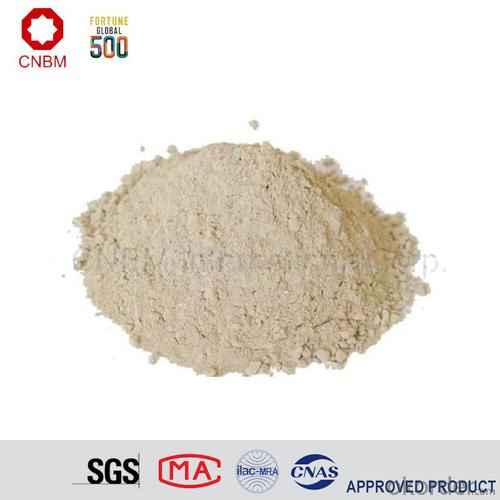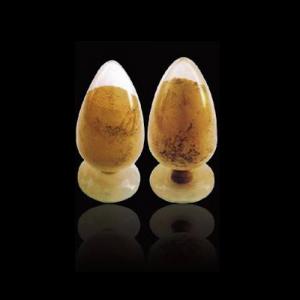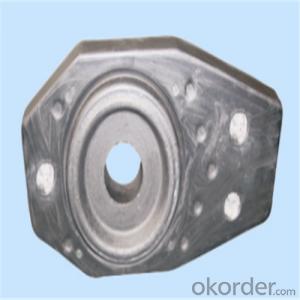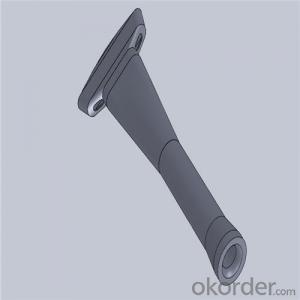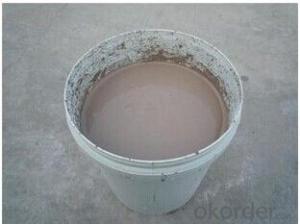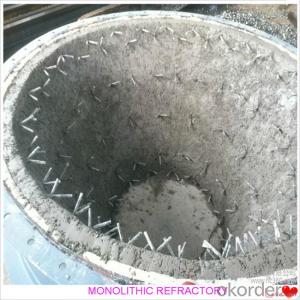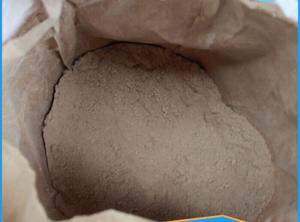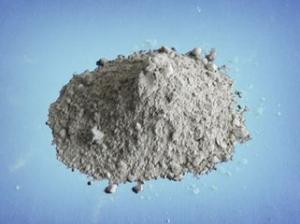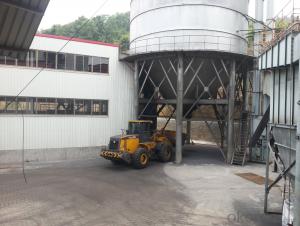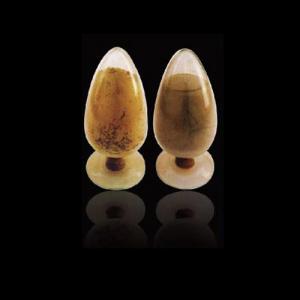Monolithic High Temperature Castable Refractory Cement for Iron and Steel Industry
- Loading Port:
- Dalian
- Payment Terms:
- TT or LC
- Min Order Qty:
- 23 m.t.
- Supply Capability:
- 60000 m.t./month
OKorder Service Pledge
OKorder Financial Service
You Might Also Like
Refractory Plants
Our plant is one of the research institutes on refractory materials in CNBM. It was set up in 2001. Taking the advantages of combining research,process,marketing and technical service,CNBM supply not only first-class refractory materials but also supply distinctive technical services.
·17 plants in different cities.
·Annual output is 5000,000 tons per year.
·ISO 9001:2008 certificated
·The products cover the refractory area of steel-making, cement, non-ferrous, glass, ceramic and others.
Physical And Chemical Indicators For Castable
| Brand Properties | HCA-180 | HCA-170 | HCA-160 | HCA-150 | HCA-140 | |
| ºC Application Limit Temp | 1,800 | 1,700 | 1,600 | 1,500 | 1,400 | |
Bulk Density (g/cm3) | 2.95 | 2.45 | 2.30 | 2.15 | 2.10 | |
| (%)Water Required for Casting | 8-11 | 10-14 | 10-14 | 11-15 | 11-15 | |
CCS/MOR (MPa) | at110ºCx24h | 60(10) | 45(8.5) | 40(8) | 40(8) | 35(6) |
| at1,200ºCx3h | 55(9.5) | 50(9) | 45(8.5) | 50(9) | 40(8) | |
| at1,400ºCx3h | 80(15) | 55(10) | 50(9) | 55(9.5) | 45(8.5) at1,300ºC | |
| (%) Permanent Linear Change | at110ºCx24h | -0.03 | -0.06 | -0.06 | -0.06 | -0.06 |
| at1,200ºCx3h | -0.1 | -0.2 | -0.2 | -0.15 | -0.15 | |
| at1,400ºCx3h | +0.4 | -0.3 | -0.2 | -0.3 | -0.4 at 1,300ºC | |
| (%) Chemical Analysis | Al203 | 91 | 76 | 63 | 52 | 48 |
| SiO2 | 1.5 | 15 | 27 | 40 | 44 | |
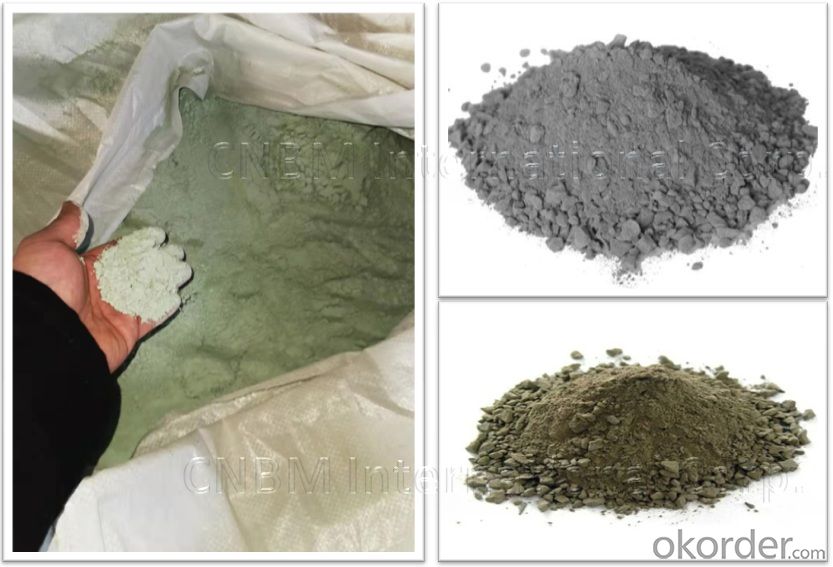
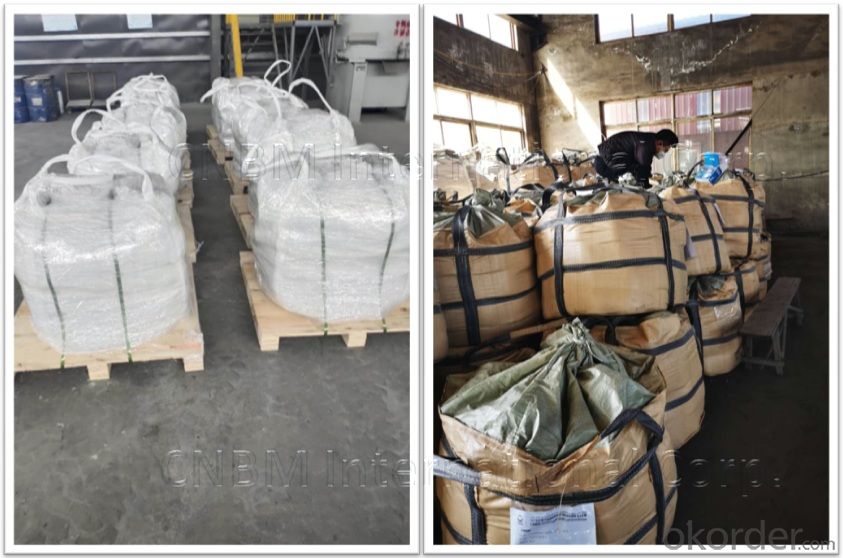
Features Of Castable
High refractoriness, High refractoriness under load
High density, low porosity
Good slag resistance and corrosion resistance
High strength and wear resistance
Good resistance to flake performance
Good thermal shock stability
Scouring resistance
Good hot strength.
Applications Of Castable
Nonferrous Metal Furnace
Various Incinerator
Reheating Furnace
EAF, Ladle, Tundish, etc.
Specifications Of Castable
It is widely used in key area of linings in metallurgical industry, petrochemical industry, power plant, construction field and other industries. Especially for the areas where easily worn and broken
Company Profile
CNBM INTERNATIONAL CORPORATION
Build your world with our materials.
We are a primary subsidiary of China National Building Material Group Co., Ltd.
CNBM Group is a central government-owned enterprise and a Fortune Global 500 company (Ranking 203th in 2019). It is the largest building material manufacturer and service provider in the world, with 15 publicly-listed companies and over 180,000 employees (2019). We have more than 300 factory plants in China. For the refractory, we are top 3 in China. We have more than 17 plants in different cities.
Proprietary Technology & Patented Products
Refractory technology
All process are conform to ISO9001 quality control systems
(1)The test of raw materials
★For all raw materials, the purchase department give the test report to the quality supervision department.
(2)The control of production
★Each batch products will be tested
★The quality supervision department record all test result.
(3)Test Before Production
★Before packing, the quality supervision department test the chemical content and physical
★Only quality products can be delivery.
★The delivery department check the package, quantity, name, code, production date, etc.
(4)Quality Traceability Analysis
★Track the products after using and get the feedback of performance.
If customer required, we will give the customer technical solutions and also improve the products.
Damage Mechanism Analysis and Improvement
★ For the maintenance project, CNBM will check the damage condition of the refractory materials in the furnace carefully.
★And then CNBM will give the damage mechanism analysis report to the customer.And CNBM also will provide products improvement solutions to extend the products' service life.
Technical Solution& Construction
★Optimization solutions of the original design to the customer.
★Consultation Service of Refractories Technology
★Technical Staff Training in Refractories Technology
★Specialized Design and Refractories Selection
FAQ
Q:Are you a trading company or manufacturer?
A:CNBM is a large-scale central governmental industrial group with its own manufacturing sector, research and development sector, trading sector and logistics sector.
Q:I have some special requirement about specifications.
A:We have a well-rounded product range, which endows us with the capability of applying many special specifications. Please feel free to contact us with yours.
Q:Do you accept OEM service?
A:Yes, we do.
Q:What is your delivery time?
A:It depends on the size/complexity of your order and our own production schedule. Usually we provide a faster delivery than the industry's average.
Q:What is the payment term?
A:Our payment terms are negotiable.
Q:Can I have my own logo on the product?
A:Sure, we can apply your own logo on the products according to your drawings.
- Q: How do monolithic refractories withstand high temperatures and thermal cycling?
- Monolithic refractories, with their unique composition and structural characteristics, are designed to endure high temperatures and thermal cycling. To begin with, these refractories are composed of high-quality raw materials like alumina, silica, and magnesia. These materials possess exceptional thermal properties, including high melting points and low thermal conductivity. Consequently, they can maintain their strength and integrity even in extreme temperatures. Additionally, monolithic refractories are engineered to have a dense and compact microstructure. This dense structure prevents the infiltration of heat and gases, minimizing thermal shock and crack formation. Moreover, the compact microstructure enhances the refractory's thermal conductivity, allowing it to efficiently distribute and dissipate heat. Furthermore, special additives and bonding agents are often incorporated into monolithic refractories to enhance their resistance to thermal cycling. These additives improve the refractory's thermal expansion properties, enabling it to expand and contract without cracking or spalling during rapid temperature changes. Some bonding agents also provide flexibility to the refractory, allowing it to withstand thermal stresses without compromising its structural integrity. In addition to these inherent characteristics, proper installation techniques are crucial for the refractory's ability to withstand high temperatures and thermal cycling. Careful application and curing ensure uniformity and minimize the development of internal stresses. Adequate curing and heat treatment processes create a strong and durable bond between the refractory and the substrate, enhancing its resistance to thermal shock and cyclic thermal loading. In summary, the composition, microstructure, and installation techniques of monolithic refractories work together to enable them to withstand high temperatures and thermal cycling. These factors result in excellent thermal conductivity, resistance to thermal shock, and the ability to expand and contract without compromising the refractory's structural integrity.
- Q: How do monolithic refractories contribute to the overall safety of iron and steel operations?
- Monolithic refractories play a crucial role in ensuring the overall safety of iron and steel operations. These refractories are designed to withstand extreme temperatures, chemical reactions, and mechanical stresses, providing a protective barrier to the furnaces, ladles, and other equipment used in these operations. By maintaining the integrity of the refractory lining, monolithic refractories prevent leaks, minimize the risk of thermal shock, and reduce the chances of equipment failure or accidents. This helps to safeguard the workers, prevent damage to the infrastructure, and ensure the uninterrupted production of iron and steel, thus contributing to the overall safety of the operations.
- Q: How do monolithic refractories withstand thermal shock and mechanical stress?
- Monolithic refractories are designed to withstand thermal shock and mechanical stress due to their unique composition and installation process. These refractories are made from a single, continuous material, eliminating any joints or seams that could weaken the structure. Additionally, they have a high thermal conductivity which allows them to efficiently distribute and dissipate heat, minimizing thermal gradients that can cause cracking. Furthermore, the installation technique involves forming the refractory in situ, ensuring a tight fit and reducing the likelihood of mechanical failure. Overall, the combination of their composition, thermal conductivity, and installation method enables monolithic refractories to withstand thermal shock and mechanical stress effectively.
- Q: How do monolithic refractories contribute to the overall efficiency of steel ladle operations?
- Monolithic refractories play a crucial role in enhancing the overall efficiency of steel ladle operations. They provide a protective lining that withstands extreme temperatures, chemical reactions, and mechanical stresses during the steelmaking process. This lining helps to retain heat and prevent heat loss, ensuring better temperature control and reducing energy consumption. Additionally, monolithic refractories minimize metal penetration and slag adhesion, improving ladle cleanliness and reducing the risk of clogging or blockages. Overall, the use of monolithic refractories in steel ladles promotes higher productivity, improved steel quality, and cost-effective operations.
- Q: How do monolithic refractories contribute to the efficiency of iron and steel production?
- Monolithic refractories play a crucial role in improving the efficiency of iron and steel production by providing superior thermal insulation and resistance to high temperatures, resulting in reduced heat loss and improved energy efficiency. Additionally, these refractories offer excellent mechanical strength and chemical resistance, enabling them to withstand the harsh conditions within the production process, leading to increased durability and extended service life. Their ability to be easily shaped and installed also facilitates faster maintenance and repair, minimizing downtime and enhancing overall operational efficiency in the iron and steel industry.
- Q: How do monolithic refractories enhance the efficiency of reheating furnaces?
- Monolithic refractories enhance the efficiency of reheating furnaces by providing better thermal insulation, reducing heat loss, and improving the overall heat transfer within the furnace. These refractories have excellent resistance to high temperatures and thermal shock, allowing them to withstand extreme conditions for prolonged periods. By minimizing heat loss and maintaining a consistent temperature, they ensure that the reheating process is more energy-efficient, resulting in reduced fuel consumption and increased productivity.
- Q: How do monolithic refractories contribute to the reduction of emissions in iron and steel plants?
- The role of monolithic refractories in iron and steel plants is crucial for reducing emissions and addressing environmental challenges. These refractories are utilized to line the high-temperature areas of furnaces, including blast furnaces and electric arc furnaces, which are vital for the production processes of iron and steel. The exceptional thermal insulation properties of monolithic refractories help to minimize heat loss and enhance energy efficiency. This reduction in heat loss translates to lower energy consumption and emissions as less fuel is required to maintain the desired temperature. Furthermore, monolithic refractories contribute to emissions reduction by optimizing the combustion process. Their ability to withstand extreme temperatures and resist thermal shock ensures that the furnaces operate at their optimal conditions. This leads to more efficient combustion of fuels and raw materials, resulting in a decrease in the release of harmful gases and pollutants into the atmosphere. Additionally, these refractories possess excellent resistance to chemical attacks and corrosion, which is particularly important in iron and steel plants where aggressive substances like molten metal, slag, and gases are present. By providing a protective lining, they prevent the degradation of furnace walls and equipment, reducing the risk of leaks and emissions. Moreover, monolithic refractories find application in the construction of pollution control devices such as flue gas desulfurization systems and baghouses. These systems are designed to capture and remove pollutants from the flue gases generated during iron and steel production. The use of refractories in these systems ensures their durability and longevity, enabling them to efficiently and effectively reduce emissions. In summary, monolithic refractories play a vital role in reducing emissions in iron and steel plants by improving energy efficiency, optimizing combustion, providing corrosion resistance, and supporting pollution control systems. Their implementation allows the industry to minimize its environmental impact and transition towards more sustainable and responsible production processes.
- Q: What are the advantages of using monolithic refractories in electric arc furnaces?
- There are several advantages to using monolithic refractories in electric arc furnaces. Firstly, monolithic refractories offer excellent thermal shock resistance. Electric arc furnaces operate at extremely high temperatures, and the refractory lining is constantly exposed to rapid temperature changes. Monolithic refractories are able to withstand this thermal cycling without cracking or deteriorating, ensuring the longevity and efficiency of the furnace. Secondly, monolithic refractories have superior corrosion resistance. Electric arc furnaces often use aggressive slag compositions, which can corrode and erode traditional brick linings. Monolithic refractories, on the other hand, are specifically designed to resist chemical attack, providing long-lasting protection against the corrosive effects of molten metal and slag. Additionally, monolithic refractories offer great flexibility in terms of installation. Unlike brick linings, which require extensive labor and time to construct, monolithic refractories can be easily applied as a liquid or paste, allowing for faster and more efficient installation. This not only reduces downtime during furnace maintenance or repairs but also provides the opportunity for customized linings to be easily created to suit specific furnace designs. Moreover, monolithic refractories have excellent thermal conductivity. This property allows for efficient heat transfer within the electric arc furnace, ensuring optimal energy use and minimizing heat losses. This improved thermal efficiency results in reduced operating costs and increased productivity. Furthermore, monolithic refractories have a high refractoriness, meaning they can withstand extremely high temperatures without deformation or failure. This is crucial for electric arc furnaces, which operate at temperatures exceeding 3000°C. The ability of monolithic refractories to maintain their structural integrity at such extreme temperatures ensures the safe and efficient operation of the furnace. In conclusion, the advantages of using monolithic refractories in electric arc furnaces include their thermal shock resistance, corrosion resistance, ease of installation, high thermal conductivity, and exceptional refractoriness. These properties contribute to improved furnace performance, increased productivity, reduced operating costs, and extended furnace life.
- Q: How do monolithic refractories perform in torpedo ladle applications?
- Due to their excellent performance and durability, monolithic refractories are commonly used in torpedo ladle applications. Torpedo ladles are utilized in the steelmaking process to transport and pour molten metal from the blast furnace to the steelmaking furnace. Also known as unshaped refractories, monolithic refractories are made from a single material and can be applied as a cohesive mass, making them highly versatile and easy to install in the torpedo ladle. In torpedo ladle applications, monolithic refractories offer numerous advantages. Firstly, they possess high heat resistance, enabling them to endure the extreme temperatures and thermal shocks experienced during the transfer and pouring of molten metal. This ensures that the refractories do not crack or fail under these harsh conditions. Additionally, monolithic refractories exhibit excellent corrosion resistance properties, which is imperative in torpedo ladles where the molten metal can be highly corrosive. They can withstand the aggressive chemical environment and prevent chemical reactions that could result in refractory deterioration. Moreover, monolithic refractories possess good thermal insulation properties, reducing heat loss from the molten metal and promoting energy efficiency. This helps to maintain the desired temperature of the metal, ensuring optimal steelmaking conditions. Furthermore, monolithic refractories offer strong mechanical strength and resistance to abrasion, making them highly suitable for torpedo ladle applications where the refractory lining is subjected to mechanical stress and wear. Overall, monolithic refractories perform exceptionally well in torpedo ladle applications due to their high heat resistance, corrosion resistance, thermal insulation properties, and mechanical strength. They can endure the extreme conditions and provide a reliable and long-lasting lining for torpedo ladles in the steelmaking industry.
- Q: How do monolithic refractories contribute to the control of spalling in iron and steel processes?
- Monolithic refractories play a crucial role in controlling spalling in iron and steel processes. Spalling refers to the phenomenon of the refractory material breaking or flaking off due to thermal stress, mechanical stress, or chemical reactions. This can lead to severe damage to the lining of the furnace or kiln, reducing its efficiency and productivity. To address this issue, monolithic refractories are specifically designed to be more resistant to spalling compared to traditional brick or tile refractories. They are composed of a single, homogenous material that is able to withstand high temperatures and thermal shock, making them less prone to cracking or breaking under extreme conditions. The ability of monolithic refractories to control spalling in iron and steel processes is primarily attributed to their high thermal conductivity and low thermal expansion properties. These characteristics allow them to effectively distribute and absorb the intense heat generated during melting or heat treatment processes, minimizing the thermal stress on the refractory lining. Additionally, monolithic refractories offer better resistance to chemical reactions and erosion caused by molten metal, slag, or gases that are present in iron and steel processes. They are formulated with additives and binders that enhance their chemical stability and protect against corrosion, reducing the risk of spalling due to chemical attack. Furthermore, the monolithic nature of these refractories eliminates the need for joints or seams, which are common weak points in traditional brick or tile refractories. This seamless design ensures a more uniform and durable lining, reducing the chances of spalling occurring at these vulnerable areas. Overall, monolithic refractories contribute significantly to the control of spalling in iron and steel processes by providing superior thermal conductivity, low thermal expansion, chemical resistance, and a seamless lining. This helps to maintain the integrity of the refractory lining, prolonging its lifespan and ensuring efficient and safe operation of the furnace or kiln.
Send your message to us
Monolithic High Temperature Castable Refractory Cement for Iron and Steel Industry
- Loading Port:
- Dalian
- Payment Terms:
- TT or LC
- Min Order Qty:
- 23 m.t.
- Supply Capability:
- 60000 m.t./month
OKorder Service Pledge
OKorder Financial Service
Similar products
Hot products
Hot Searches
Related keywords





